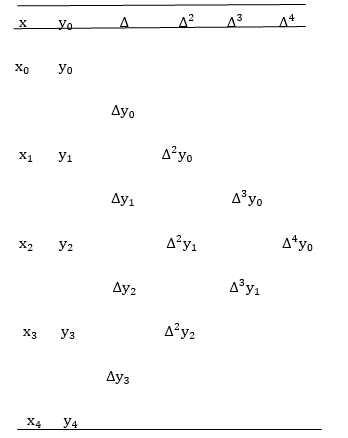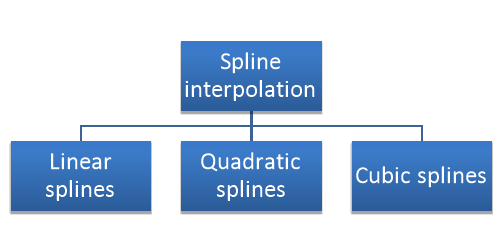Unit - 3
Polynomial interpolation
Q1) Explain interpolation.
A1)
Definition:
Interpolation is a technique of estimating the value of a function for any intermediate value of the independent variable while the process of computing the value of the function outside the given range is called extrapolation.
Let  be a function of x.
be a function of x.
The table given below gives corresponding values of y for different values of x.
X |  |  |
 | …. |  |
y= f(x) |  |  |  | …. |  |
The process of finding the values of y corresponding to any value of x which lies between  is called interpolation.
is called interpolation.
If the given function is a polynomial it is polynomial interpolation and given function is known as interpolating polynomial.
Thus interpolation is the “art of reading between the lines of a table.”
Q2) What do you understand by forward difference?
A2)
a) The  are called differences of y, denoted by
are called differences of y, denoted by 
The symbol  is called the forward difference operator. Consider the forward difference table below:
is called the forward difference operator. Consider the forward difference table below:

Where 
And  third forward difference so on.
third forward difference so on.
Q3) Construct a backward difference table for y = log x, given-
X | 10 | 20 | 30 | 40 | 50 |
y | 1 | 1.3010 | 1.4771 | 1.6021 | 1.6990 |
A3)
The backward difference table will be-
 |  |  |  |  |  |
10
20
30
40
50
| 1
1.3010
1.4771
1.6021
1.6990
|
0.3010
0.1761
0.1250
0.0969
|
-0.1249
-0.0511
-0.0281
|
0.0738
0.0230 |
-0.0508
|
Q4) Explain divided difference.
A4)
Definition: The difference which are defined by taking into consideration the change in the value of the argument are known as divided differences.
Let  be a function defined as
be a function defined as
 |  |  | ……. |  |
 |  |  |
………… |  |
Where  are unequal i.e. it is case of unequal interval.
are unequal i.e. it is case of unequal interval.
The first order divided differences are:


 And so on.
And so on.
The second order divided difference is:


 And so on.
And so on.
Similarly the nth order divided difference is:

Q5) What is Newton’s divided difference formula.
A5)
Let  be a function defined as
be a function defined as
 |  |  | ……. |  |
 |  |  |
………… |  |
Where  are unequal i.e. it is case of unequal interval.
are unequal i.e. it is case of unequal interval.
 .
.
Q6) By means of Newton’s divided difference formula, find the values of  from the following table:
from the following table:
x | 4 | 5 | 7 | 10 | 11 | 13 |
f(x) | 48 | 100 | 294 | 900 | 1210 | 2028 |
A6)
We construct the divided difference table is given by:
x | f(x) | First order divide difference | Second order divide difference | Third order divide difference | Fourth order divide difference |
4
5
7
10
11
13 | 48
100
294
900
1210
2028 |




 |



 |


 |
0
0 |
By Newton’s Divided difference formula
 .
.

Now, putting  in above we get
in above we get
 .
.


Q7) The following values of the function f(x) for values of x are given:

Find the value of  and also the value of x for which f(x) is maximum or minimum.
and also the value of x for which f(x) is maximum or minimum.
A7)
We construct the divide difference table:
x | f(x) | First order divide difference | Second order divide difference | Third order divide difference |
1
2
7
8 | 4
5
5
4 |



|


|
0 |
By Newton’s divided difference formula
 .
.



Putting  in above we get
in above we get

For maximum and minimum of  , we have
, we have



Or 
Q8) Find a polynomial satisfied by  , by the use of Newton’s interpolation formula with divided difference.
, by the use of Newton’s interpolation formula with divided difference.
A8)
F(x) | 1245 | 33 | 5 | 9 | 1335 |
Here
We will construct the divided difference table:
x | F(x) | First order divided difference | Second order divided difference | Third order divided difference | Fourth order divided difference |
-4
-1
0
2
4 | 1245
33
5
9
1335 |




|


 |

 |
 |
By Newton’s divided difference formula
 .
.



This is the required polynomial.
Q9) Deduce Lagrange’s formula for interpolation. The observed values of a function are respectively 168,120,72 and 63 at the four position3,7,9 and 10 of the independent variable. What is the best estimate you can for the value of the function at the position6 of the independent variable.
A9)
We construct the table for the given data:
X | 3 | 6 | 7 | 9 | 10 |
Y=f(x) | 168 | ? | 120 | 72 | 63 |
We need to calculate for x = 6, we need f(6)=?
Here 
We get 
 By Lagrange’s interpolation formula, we have
By Lagrange’s interpolation formula, we have



Hence the estimated value for x=6 is 147.
Q10) By means of Lagrange’s formula, prove that

A10)
We construct the table:
X | 0 | 1 | 2 | 3 | 4 | 5 | 6 |
Y=f(x) |  |  |  |  |  |  |  |
Here x = 3, f(x)=?
 By Lagrange’s formula for interpolation
By Lagrange’s formula for interpolation




Hence proved.
Q11) Find the polynomial of fifth degree from the following data
X | 0 | 1 | 3 | 5 | 6 | 9 |
Y=f(x) | -18 | 0 | 0 | -248 | 0 | 13104 |
A11) Here 
We get 
 By Lagrange’s interpolation formula
By Lagrange’s interpolation formula







Q12) Explain about the errors in interpolation.
A12)
We know that, the interpolation means to estimate a missing function value by taking a weighted average of known function value at neighbouring points.
Let y = f(x) is the known function at (n + 1) points .
.
A polynomial of degree n.  is known as the interpolating polynomial when
is known as the interpolating polynomial when  passes through these (n + 1) points.
passes through these (n + 1) points.
 can be constructed using only the numerical values
can be constructed using only the numerical values  and
and  and does not need any order derivatives of f (x). The approximation
and does not need any order derivatives of f (x). The approximation  is known as interpolated value when
is known as interpolated value when  and extrapolated value when
and extrapolated value when  or
or  .
.
Note- Error increases when the number of interpolation is increased.
The error of the polynomial is obtained by the generalized Rolle’s theorem,
It is given as-

Here  contains {x,
contains {x,  }
}
Note- that the error term given above is same for Lagrange polynomial and interpolating polynomial obtained from divide difference table
Q13) What are average and shift operators?
A13)
Averaging operator ( :
:
It is defined as- 
Shift operator E:
It is the operation of increasing the argument x by h so that
Ef(x) = f(x + h)
 f(x) = f(x + 2h) and so on.
f(x) = f(x + 2h) and so on.
The inverse operator  is defined by
is defined by

Q14) Prove that

A14)
By taking left hand side, we get-




Q15) Prove that-

A15)


From (1)-

Hence proved.
Q16) By using Gauss forward difference formula obtain f(32) given that-
f(25) = 0.2707 f(35) = 0.3386
f(30) = 0.3027 f(40) = 0.3794
A16)
Here

Let us take the origin at 30, a = 30 then we get-
u = 0.4
The forward difference table-
u | x | F(x) |  |  |  |
-1
0
1
2
| 25
30
35
40 | 0.2707
0.3386
0.3794 |
0.032
0.359
0.408 |
0.0049 |
0.0010 |
By using Gauss forward difference formula, we get-



Q17) Using Gauss’s backward interpolation formula, find the population for the year 1936 given that-
Year | 1901 | 1911 | 1921 | 1931 | 1941 | 1951 |
Population(in thousands) | 12 | 15 | 20 | 27 | 39 | 52 |
A17)
Let origin is at 1941 and h = 10
Then-

Which gives-

The backward difference table-
u | F(u) |  |  |  |  |  |
-4
-3
-2
-1
0
1
| 12
15
20
27
39
52 |
3
5
7
13 |
2
2
5
1
|
0
3
-4
|
3
-7 |
-10
|
By using Gauss backward formula, we get-


 thousands
thousands
Hence the pop. Of the year 1936 is 32625
Q18) Explain spline interpolation.
A18)
The approximation of arbitrary functions on a closed interval becomes oscillatory for higher-degree polynomials. By dividing the given interval into a collection of subintervals, piecewise polynomial approximation consists of constructing a different approximating polynomial on each subinterval. Cubic spline interplation is the most common piecewise approximation using cubic polynomial, known as spline function, connecting each pair of data points. Cubic splines are third-order curves employed to connect each pair of data points.

Q19) Fit a linear spline of the data given below:
X | 1 | 3 | 6 | 8 |
F(x) | 4 | 5.5 | 7 | 9.5 |
A19)
Here we have, n = 4 and there are 3 intervals.
Let us assume that-
 ,
,  ,
,  ,
, 
 ,
,  ,
,  ,
, 
And the slope,

Similarly we can find,


As we know that the



The three splines will be-



Q20) What do you understand by quadratic spline?
A20)
These are called the second order splines.
For each interval, we fit a parabola give by-

For n + 1 data points we have n intervals. So we should determine 3 × n unknown constants. The 3n condition to find the 3n unknowns are given by the following equations.
- At the interior knots, the function values must be-


For i = 2, n giving raise to 2(n − 1) = 2n – 2 conditions.
2. The first and last functions must pass through the two end points 


Giving two conditions.
3. At the interior knots, the first derivatives f (x) = 2ax + b must be equal.

For i = 2 to n giving n − 1 conditions
4. Assume that the second derivative is zero at the first point . Then the first two points are connected by a straight line, so
. Then the first two points are connected by a straight line, so 
Thus solving (2n − 2) + 2 + (n − 1) + 1 = 3n conditions above we obtain the 3n unknown constants a, b and c.





